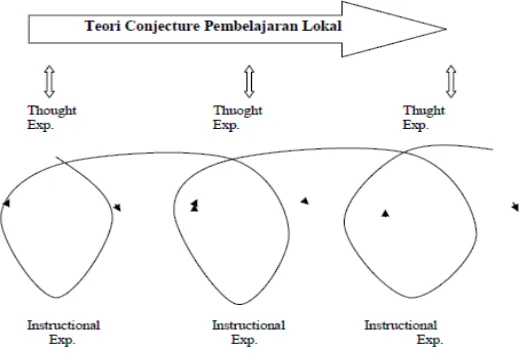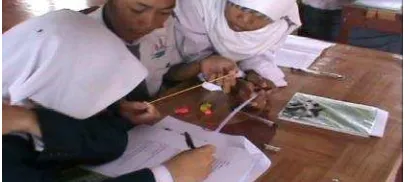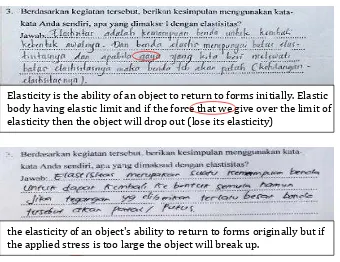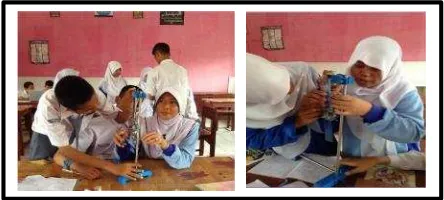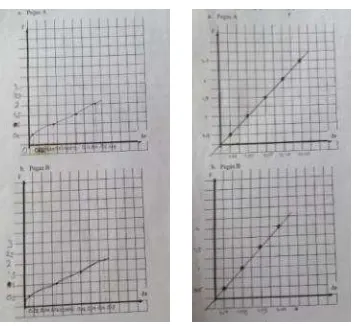THE USE OF HYPOTHETICAL LEARNING TRAJECTORY (HLT) IN
ELASTICITY SUBJECT MATTER TO DETERMINE THE LEARNING
TRAJECTORY OF TENTH GRADE STUDENTS OF SMA NEGERI 1
INDRALAYA UTARA
Putri Ramadhanti1, Sardianto Markos Siahaan2, Apit Fathurohman3 Sriwijaya University1,2,3
1) [email protected], 2) [email protected], 3) [email protected]
Abstract
This study aims to develop a learning trajectory about elasticity for tenth grade students of SMA Negeri 1 Indralaya Utara by using Hypothetical Learning Trajectory (HLT). The method used in this study is design research. The subjects of this research were six students in the pilot experiment and 24 students in the teaching experiment. A set of activities designed in HLT was applied and developed to gain the understanding of elasticity concept. The HLT designed during the preparation phase was compared to the students’ actual learning trajectory during the implementation in the teaching experiment. Retrospective analysis of the teaching experiment showed that students have diverse conjecture thinking in understanding the concept of elasticity. This learning trajectory describes the
development of student’s understanding in material of elasticity during the learning process
that consists of learning goals, learning activities and conjecture of students’ thinking. Some students assumed that all spring have the same constants, after Hooke’s law experiment and created the graphs of Hooke’s law; student understood that the elasticity of the spring depends on the spring constant. It was got by students analyzing about the relationship of force F with the length of the spring (extension ∆�). Based on this research, it was found that the use of HLT could determine the students' learning trajectory in understanding the concept of elasticity.
Keywords: Hypothetical Learning trajectory, Learning Trajectory, Elasticity, Design Research.
INTRODUCTION
The relevance between physics with everyday life should make physics as a fascinating science to be learned. Learning physics has been considered unattractive because it only emphasizes the mathematical formulas without excavate from the basic concept first. Dahar (2011: 2) states that the concept is like a stone the builders thought. An attractively packaged concept can develop creative thinking students so that they can understand and apply it in everyday life.
students' understanding of constructing a concept of physics (Kemendikbud, 2013). The success of science learning is closely linked to the ability of a teacher to plan a lesson before teaching.
One of the real forms of the learning plan is Rencana Pelaksanaan Pembelajaran (RPP). Based on the experience of researchers, plan an ideal learning and understandable students are not easy. Predictions in this case related to how the ability of thinking and understanding of students will develop in a learning activity that has been designed by the teacher. In accordance with the statement of Wijaya (2009) that the teacher should prepare an alternative hypothesis. With an alternative hypothesis, problem solving strategies that used by students will assist the teachers in determining the strategy treatment for possible difficulties that faced by students.
The research that developed to predict the response of students is Hypothetical Learning Trajectory (HLT). Simon (in Bardsley, 2006) first introduced the Hypothetical Learning Trajectory (HLT) to characterize the reflexive nature of learning design and consideration of students' learning difficulties in the classroom. Hypothetical Learning Trajectory s a learning path provided by the teacher based on the rationale for selecting specific instructional design, so that the students understood the concept of elasticity. The importance of HLT could be analogous to the route of planning. If we understand these possible routes to get the goal, we can choose a route that is possible to achieve our goals so we can choose the best route (Wijaya, 2009). By knowing the trajectory of student learning, teacher (in this case the researcher) can get the right learning sequence to help students understanding a concept.
Elasticity is a physics matter is taught in tenth grade student of the second semester. Elasticity material in tenth grade student discusses the elasticity limit object, stress, strain, modulus of elasticity, and Hooke's law. All solids are rather elastic, although apparently not elastic. Provision of compressive force and tensile strength could be changing the shape of a rigid body. However, students often assume that the objects were solid (rigid) cannot be compressed or stretched (Suparno, 2013). So that, the researchers are interested in designing and developing the learning activities that contained in the HLT to help students in understanding a concept and to achieve the meaningful learning.
Preliminary study goes to schools to that implemented the 2013 Curriculum. SMA Negeri 1 Indralaya is one of schools in South Sumatra that are being implemented the 2013 Curriculum. During preliminary studies to schools, the researchers observe the teaching and learning activities in the class. The researchers became interested to knowing how the students' learning trajectories in understanding a concept, so hopefully this study will produce a learning plan that is right in the material of elasticity of tenth grade students. SMA Negeri 1 Indralaya Utara as subject in this study is based on interviews with a physics teacher at the school that supports the school laboratory facilities for practical activities.
Based on these considerations, the researcher is interested to conduct a study with a research question: How is the student’s learning trajcetory of tenth grade student of SMA Negeri 1 Indralaya Utara by using the Hypothetical Learning Trajectory (HLT)?
THEORETICAL FRAMEWORK
The Essence of Physics Learning
According to Permendikbud No. 59 of 2014, physics is part of the Natural Sciences (IPA) which is a systematic effort in order to build and organize knowledge in the form of explanations that can be tested and able to predict natural phenomena. Further explained that the function of physics is to develop the experience to use the scientific method in formulating the problem, propose and test hypotheses through experimentation, design and assemble the experimental instrument, collecting, processing and interpreting the data, and communicate the results of the experiment orally and in writing. So studying physics cannot be separated from the mastery of basic concepts of physics through understanding.
Hypothetical Learning trajectory (HLT)
The term "learning trajectory (trajectory study)" was first proposed by Marty Simon in 1995 (Daro et al., 2011: 18) which was developed by Freudenthal. Hypothetical learning trajectory (HLT) refers to the guidelines for the implementation of learning as well as an anticipatory action to the possibility problems faced by students in the learning process. Marty Simon (in Bardsley, 2006:14):
The hypothetical learning trajectory is made up of three components: the learning goal that defines the direction, the learning activities, and the
hypothetical learning process a prediction of how the students’ thinking and
understanding will evolve in the context of the learning activities.
Characteristics of Elasticity Subject Matter of Tenth Grade Student
2013). If a rigid body deformed (deformation) little, things soon return to its original shape when the compressive force or tensile force eliminated. If the rigid body deformed beyond its elasticity, things will not return to its original shape when the force removed, but will deform permanently. Even if the change of shape far exceeded the limits of its elasticity, the object will break up.
METHOD
The method of this study is Design Research. Based on Gravemeijer and Cobb (2006), this method consists of three phases, which are preparing for the experiment, experimenting in the classroom and retrospective analysis. This design research consists of cycles, which elaborated below:
Figure 1. The Cycle of Design Research
This research was conducted at SMA Negeri 1 Indralaya Utara by involving 6 students in the pilot experiment phase. The data that collected in this study was video recording of interviews, video during the learning process in the pilot and teaching experiment, photos, field notes, and also students worksheet. All the collected data were analyze in
the retrospective phase. The (LT was compare with the student’ actual learning and
learning process in the classroom.
RESULT AND DISCUSSION
This research produce the learning trajectories of Elastcity Subject Matter of SMA Negeri 1 Indralaya Utara. All the data that have been collected from the following steps, preparing for the experiment), experimenting in the classroom and retrospective analysis. Before the study began, the teacher conducted interviews to determine students' first knowledge. Teachers see students already opened handle physics book.
Fragment 1. Interviewing some students 1. Teacher : What is Elasticity?
2. Inna : Objects that can be returned to its original shape . 3. Teacher : Any other answer to complete )nna’s?
5. Teacher : What are the example?
6. Students : Rubber, coil springs, balloons, toy slingshot. 7. Teacher : (ow about modulus of elasticity?
8. Inna : The combination of stress and strain" While reading the book 9. Teacher : would you like to explain about stress and strain?
All students are silent and shook their head. From the brief interview earlier, it appears that students have read the material, just the same as in the pilot experiment, only limited knowledge of their early understanding of elasticity and elastic object instance, while the stress and strain they have not understood.
1) Activity in The Teaching Experiment a. Activity 1
Demonstrating and discussing Which one the elastic object? The teacher showed the
students two objects, spring and plasticine, then start the question and answer with the students. Melly said that spring is elastic, because it can return to its shape. Then teacher asked, are there another reasons, why spring is elastic objects? Inna raised her hand and
said that because there’s stress and strain. As teacher predicted, at the beginning of the activities students already understand that the elastic body can return to its original
shape, but they don’t understand about stress and strain. Teacher asked, Are rubber always be elastic? Most of students said "No", but there were some students said "Yes". The teacher ask the reason of students, "Why the rubber are not always elastic?".
Fragment 2. Why are the rubbers not always elastic?
1. Sabrina : Because if pulled too strong it will break up, so it’ll lost its
elasticity .
2. Trian : No, Rubber catapults that if withdrawn must always return to its
original shape.
3. Endah : No Trian, rubber will break down if over the limit of elasticity. 4. Trian : What is the elasticity limit?
5. Teacher : Anyone can explain the limits of elasticity of that rubber?"
6. Endah : Limit of ability of an object that can be returned to its original shape. If there was a strong pull that exceeds the elastic limit, then
the object will be plastically or inelastic.
Figure 2. Students pulled the rubber and discussed with their group
There are some of students who are still in the understanding of the limits of elasticity of objects, but there are also of students who were confused by the elasticity of the object instead of rubber. Then the teacher took a plastic ruler and asks of students,
Students begin inconsistent with the answer. They began confused where elastic and plastic. Whereas previously they had understood that the steel ruler also elastic objects, but when asked by a plastic ruler, they said it was plastic. The teacher bends the ruler up and down. Then the teacher bends the ruler until almost broken. Students shout and
compact replied, Do not mom, it will be broken if exceeding the limit of elasticity .
From that questions and answers and demonstrations, seen that students begin understand the elastic and plastic objects as well as objects elasticity limit.
Figure 3. Students answer
Group 3 mentions "If the forces that we give too over the limit of elasticity, the object will be broken (loss of elasticity). While the answer to a group of 4, if the strain is too big objects will be broken / breaking. Teacher asked, What is a strain here? Yudis said that strain is force while pulling. Teacher asked again, Why do you write strain, why not just force? Is it different between force and strain? All students look discussing and still confused. Most of the students already know the stress and strain in elastic objects, but they have not been able to explain the stress and strain on the body. Therefore, the teacher conducts the second activity to build students' knowledge about the stress and strain.
Elasticity is the ability of an object to return to forms initially. Elastic body having elastic limit and if the force that we give over the limit of elasticity then the object will drop out (lose its elasticity)
Activity 2: Conducting the Plastic Choosing experiment.
Mrs. Feby confused how to choose a strong plastic bag. Are plastic A, B, or C? Why is that? All students answered a blue plastic of the most powerful because the material looks thicker. The same answer to the pilot experiment, as teacher prediction. Then the teacher
asked, Are those materials different? Doesn’t both are made of plastic?
All students get mixed up and began discussing with the group of their friends.
Fragment 3. Students first knowledge
1. Group : "We think it’s different mom, depending the elasticity." 2. Teacher: "What about another group?
3. Group 1: "The material both is plastic, but disparate plastic, so the elasticity is also different.
4. Teacher: "How can we know the elasticity is different?" 5. Group 1: "Seen from the material that is thick".
Answer these two groups showed they have caught that cause certain plastics stronger because of its elasticity. They have started to lead to the modulus of elasticity of the material, but they do not understand the stress and strain are then comparison of stress and strain can determine the modulus of elasticity of the material. Therefore, experiments, activities "Choosing a plastic".
Figure 4.Student activities on experimental "Plastic Choosing
What happens when you pull a plastic or rubber hammer and tongs? Whether plastic or rubber will increase long? Why did it happen? (Indicate your reasons)
Figure 5. The Answer of group 1
Figure 6. The Answer of group 2
Group 2 gives a more appropriate answer. They connect the force with the length of plastic. This is consistent with the theory that the elastic object, as long as does not exceed the limit of elasticity, then the applied force is proportional to the length or strain is directly proportional with stress.
Activity 3: Observing the use of springs in daily life, conduct experiments Hooke's law, and presents graphs Hooke's law.
Figure 7. Students are observing springs on the motorcycle
Group , and answered, it’s same. while groups and said, it’s different. Some students raise their hands.
Fragment 4. Students argument about spring 1. Teacher : Do you think that all springs are same?
2. Dominic : The spring are same, just the ways of warking are different . 3. Ossy : The springs are same, only the size are different.
4. Guru : how about another groups? Do you agree with your friends
arguments?
5. Arkom : )t’s different. We can notice when we conduct the activities outside before, there are rigid and hard spring, and another looks
more flexible.
6. Hilya : We think it’s different, because of the stress and strain that produces also different, the force applied are different too. "
The argument of some of the student representatives the group was indicate that there are two students' understanding of the concept of elasticity of the spring. Two groups have not understood the existence of spring constant elasticity level that distinguishes the spring, actually they already know that the size of the spring on a variety of different
things, but they assume all the spring are same. While the two groups again have understand the level of elasticity of the spring, it's just that they do not mention that the degree of elasticity of the spring it is often called the spring constant.
Figure 8. Graphs that drawn by students
The fourth group could represent the results of their experiment in the form of a straight line graph. If at first glance chart that they make a straight line graph, but if the note again, group 2 is more appropriate in placing a value on the x-axis range, while the fourth group although looks neat but less careful in writing down the numbers on the x-axis. Teacher asked, Why does your chart present the straight line? Group 2 said that because for every force extension that deforming on spring, will proportional with the extension before, Group 3 said that the greater of extension will be proportional with the greater of force.
CONCLUSION
Through a set of activities that have been performed, there were various strategies of students to solve problems and the ability to argue when they deliver an idea or statement in discussions. The activities which conducted to get understanding about elasticity in the tenth grade student are discussing and demonstrating Which one the
elastic object? , classifying the elastic and inelastic material, determining stress and
strain, determining the elasticity modulus of plastic, observing the use of spring in the
daily life, doing the (ooke’s Law experiment, and drawing the (ooke’s Law graph. Based on this research, it was found that the use of HLT could determine the students' learning trajectory in understanding the concept of elasticity.
REFERENCES
Ayunika, E. (2011). Pengembangan Hipotesis Trayektori Pembelajaran untuk Konsep Pecahan [Developing Hypothetical Learning Trajectory for the Concept of Fraction]. Yogyakarta: Pendidikan Matematika Universitas Sanata Dharma.
Bustang. (2013). Looking at Angels: Developing A Local Instruction Theory for Learning the Concept of Angel by Exploring the Notion of Vision Lines. Palembang: FKIP Universitas Sriwijaya.
Dahar, R. (2011). Teori-teori belajar dan pembelajaran [Theories of Studying and Learning]. Jakarta: PT. Rineka Cipta.
Daro, Phil, Mosher, F.A., & Corcoran, T. (2011). Learning Trajectories in Mathematics: A Foundation for Standards, Curriculum, Assessment, and Instruction. United States: Consortium for Policy Research in Education.
Gravemeijer, K ., & Paul, C. (2006). Design Research from a Learning Design Perspective. In: Jan Van Den Akker, Koeno Gravemeijer, Susan McKenney and Nienke Nieveen. Educational Design Research. London: Routledge.
Kanginan, Marten. (2013). Fisika Untuk SMA/MA Kelas X (Physics for SMA/MA of Tenth Grade). Jakarta: Erlangga.
Kemendikbud. (2013). Salinan Lampiran Permendikbud Nomor 69 Tahun 2013 [Transcipt of Attachment Permendikbud No 69 Years 2013]. Jakarta: Kemendikbud RI. Suparno, P. (2013). Miskonsepsi dan Perubahan Konsep dalam Pendidikan Fisika
[Misconception and Concept Changing on Physics Learning]. Jakarta: Grasindo. Wijaya, A. (2009). Hypothetical Learning Trajectory dan Peningkatan Pemahaman Konsep
